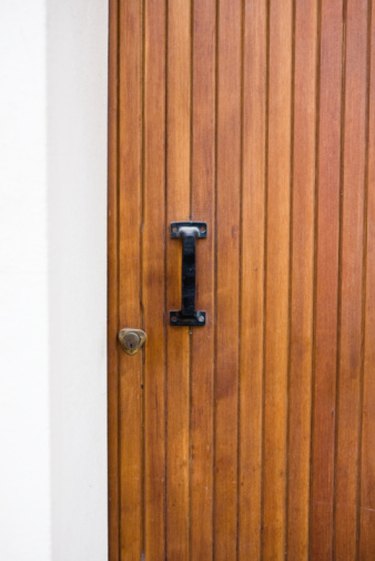When you remodel or redecorate your home, a less-expensive option to replacing old doors is to refinish your current doors or to refurbish used doors that catch your eye. Polyurethane is often applied to wood after staining to protect the surface from damage, and to refinish the door, you must first remove the polyurethane coating. While you could remove polyurethane from the door while it is hanging in place, you will find the process simpler if you take the door from its hinges prior to refinishing.

Video of the Day
Things You'll Need
Steel Wool
Putty Knife
Rubber Gloves
Sawhorses
Drop Cloth
Chemical Stripper
Screwdriver
Recommended Removal Product
Paint Brush Or Rag, Depending On Manufacturer'S Recommendation
Step 1
Prepare your work area. Lay a drop cloth on the ground, and position two sawhorses over the cloth to form a support for the door. Place the door on top of the sawhorses, with one underneath each end of the door. If working indoors, open windows and turn on fans for ventilation.
Video of the Day
Step 2
Remove all hardware from the wood door, using a screwdriver. The knob, locking mechanism and hinges must all be removed.
Step 3
Don rubber gloves. Apply chemical stripper to the top surface and sides of the door, following the manufacturer's directions. Apply a thick coat, and let it sit for the amount of time advised on the label.
Step 4
Test the progress of the stripper by scraping it away with a putty knife. It should easily scrape through to the wood, requiring little effort to remove the stripper and polyurethane. Allow more time if necessary, but do not allow the stripper to dry completely.
Step 5
Scrape away as much polyurethane as possible with the putty knife. Go slowly so you don't gouge the wood with its edges. Dip steel wool into the stripper and use it to remove stubborn areas, as well as to get into crevices and details on the wood door.
Step 6
Turn the door over. Apply and remove stripper in the same manner as for the first side.
Step 7
Clean the stripper from all sides of the wood door, following the stripper manufacturer's directions for doing so. Some chemical strippers are removed with water, while others require paint remover or turpentine.